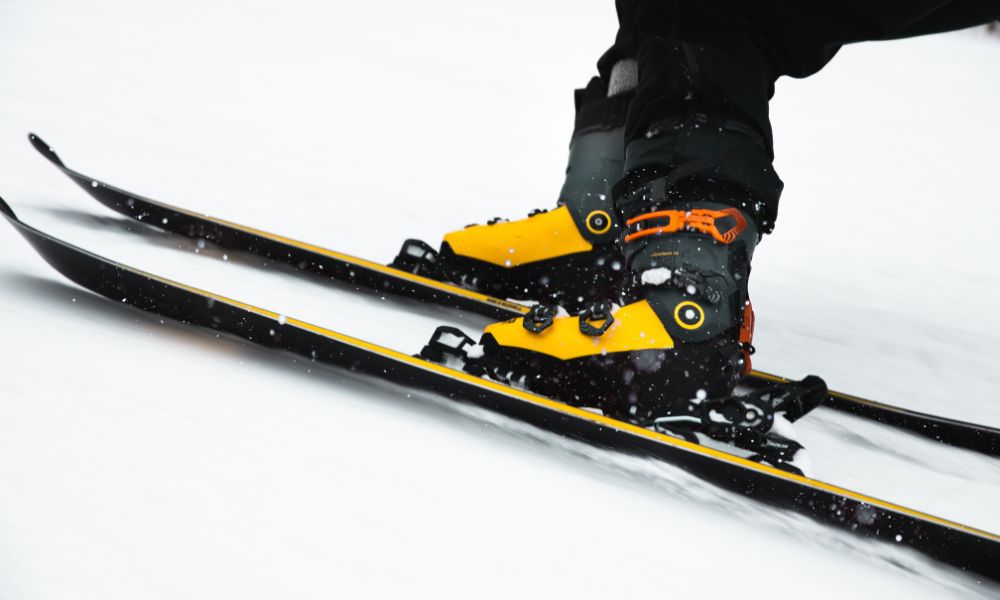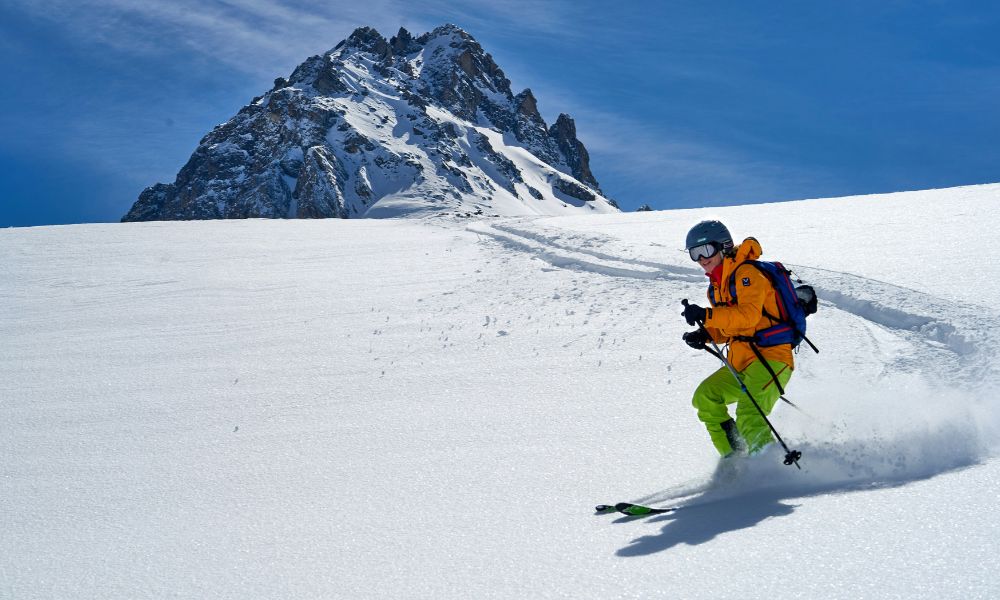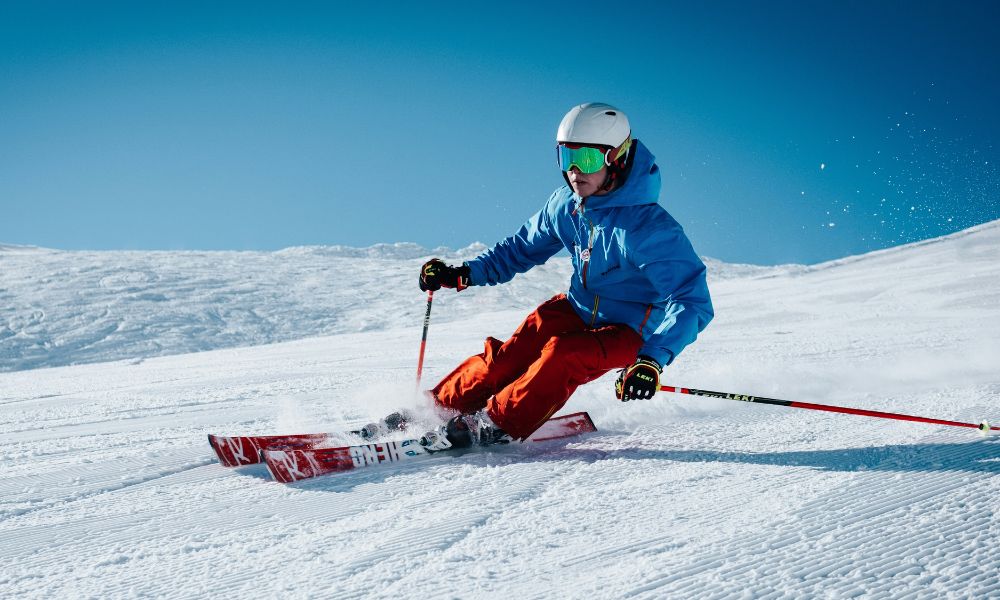Your ski boots can be the difference between the best day’s skiing you have ever had and the worst one. Poorly fitting ski boots can cause horrendous foot pain, and your skiing ability or style won’t give you the control you need. Your ski boots will make or break your mountain time, so you must get the right ones.
In this post, we will tell you how to buy ski boots to ensure you are as comfortable and in control as possible.
Jump to:
5 Important Terms to Learn Before Buying Ski Boots
There is some jargon associated with ski boots that you should know. It isn’t complicated, but it will give you more understanding of what options are available to you. Understanding the terminology will also help you get the right size and shape boot.

1. Last
The “last” is the term for the width of the ski boot. If you have a boot with a last that is wrong for your foot; you could be in a whole world of pain. Put on a thin sock and measure the width of your foot at the widest part in millimeters.
A measurement below 100mm is considered a narrow foot, while a measurement above 104mm is a wide one. Like shoe manufacturers, ski boot brands lean towards narrow or wide lasts. Therefore, you must find a brand that makes boots that fit your foot width.
2. Mondo
The Mondo (or mondopoint) refers to the length of your foot in centimeters. The best way to determine this is to go to a ski shop to get measured. It is possible to measure your foot at home.
To do this, put your foot on a piece of paper and draw around it. Then, measure from your heel to the top of your toe. This will give you your mondopoint.
3. Flex
This is how flexible the ski boot is, and it is indicated with a flex rating. Lower numbers indicate a boot is more supple, while ski boots with higher ratings are stiffer. Generally, ski boots have a flex between 60 and 150.
Boots that are easier to flex in a forward direction make it easier to control your skis. If you have stiffer boots, you must work harder to put your energy into the skis. But stiff ski boots allow you to ski harder and more aggressively.
Less experienced skiers will benefit from having softer boots, while more advanced skiers will need boots with a higher flex rating.
Your body weight will also determine the flex of your ski boots. Light people will wear boots with a lower flex rating, putting less pressure on the boot than heavier people.
4. Shell
The shell is the outer plastic part of the boot. This is where you will find the buckles and fasteners that ensure a secure fit.
5. Liner
The liner is the soft part inside the boot. These are removable, protecting your feet from the cold and vibrations. Liners can be altered or formed with heat to make them fit your feet perfectly. But you must realize that you can only expend them, not shrink them to size.
Should you visit a boot fitter?
A decent ski boot fitter will have the knowledge and experience to prevent you from making bad choices. A good ski boot fitter will ask to see your old boots if you have any.
They will ask you why you want to replace them and what you like and dislike about them. They will also ask you where you spend most of your time skiing, what type of skier you are, and how often you hit the slopes. The answers to these questions will narrow down the options for you.
When talking to the ski boot fitter, you need to be honest and realistic about your ability. Refrain from talking up or down how well you can ski. This is because you will likely end up with ski boots with the wrong flex or a pair that doesn’t match your style.
What socks should you wear?
Remember to wear thin socks and not a pair of thick ski tubes when trying on ski boots. If your boots fit correctly, you will not need thick socks for extra cushioning. Also, thick socks will misrepresent the boot’s fit, which may lead to the wrong decision.
When you think about socks, they are your first contact with the whole ski and boot setup. A thicker sock may be slightly warmer, but it will reduce control, feel, and response.
Therefore, the best skiers wear thin socks when on the mountain. A good ski boot will usually have sufficient insulation to keep your feet warm.
How Should Ski Boots Fit?

Experienced boot fitters will know what ski boots will fit you properly before you have even put one on. You will need to give feedback to the fitter on how a boot feels so he can advise you further.
When you wear a new pair of ski boots, they will feel short and tight. This is normal and nothing to be concerned about, as they should feel snug without cutting off your circulation, but you should not feel any pressure points.
A promising sign that the boot is the right fit is the feeling of slight to moderate pressure on your longest toe when the boot is bucked up when standing up straight.
If the boot is causing too much pressure on your toes, the liner may have an issue. Therefore, you can take the liner out to see if the problem lies with the liner or the shell. If it is the liner, the boot fitter can stretch it slightly to fit your foot.
Ski boots will start to pack out after you have skied in them a few times. You aim to buy some boots that will fit you perfectly at the end of the season and not while in the shop.
If you put on some ski boots in a shop and they feel perfectly comfortable and have loads of room to wiggle your toes, they are too big.
Don’t Buy Ski Boots Because They Look Cool
There are some good-looking ski boots on the market right now. These eye-catching ski boots can often sway people’s choice of which ones to buy. But those sexy boots may not fit you as well as the more plain-looking ones.
Choosing a pair of ski boots because they look good is a terrible idea, and people are more impressed by your skiing than your fancy boots.
Don’t Buy Ski Boots Based On Other People’s Experiences
Everyone’s feet are different. Also, skiing ability and technique vary from person to person, even if they have similar experience in the snow. Your friend may recommend buying the same ski boots as them.
This is because they have found the perfect pair that a professional boot fitter has picked out. However, just because they are great for your friend, they may be terrible for you.
If you go to a good ski shop, they will have a wide range of ski boots from several brands. These boots will all have their own fit, flex, and features. A professional boot fitter can advise you and pick great options that suit your budget.
When To Change Your Ski Boots
The more you use your ski boots, the more you notice they will get looser. You may start to do up the buckles harder as they don’t hug your foot as well as they used to, but this causes problems. Your boot will develop pressure points, or the extra room will allow your foot to move. Both of these could be better situations to be in.
A ski boot will last about 150 days of use. But you need to consider what a day’s skiing is for you. Do you ski non-stop from when the lifts open to when they close?
Or do you finish at lunchtime? Also, how hard you ski will make a difference to the longevity of your boots. So, all this considered, if you manage to get 30 full days on the hill per season, you will need to replace your ski boots every five years.
However, before you rush out to buy new ski boots, you may be able to get away with changing the liners. This is a much cheaper way of solving the problem. But, sometimes, a pair of ski boots is too far gone to get away with just changing the liner.
There are a few things to check when deciding if your ski boots need changing. These are also good points to check if you are buying used boots.
1. Buckles
Check that your buckles are not damaged and still work as they should. Some buckles can be replaced, depending on the age and model of the boot.
2. Shell
Over time, the boot’s shell can be weakened from UV light exposure and extreme weather conditions. This means the shell can crack, compromising the boot’s integrity.
3. Boot/Binding Interface
The parts that clip into your bindings wear out over time. This can be dangerous, as the biding struggles to hold the boot. Some ski boots have replaceable heel and toe pads. If yours are worn, and your boots don’t have replaceable pads, it is time to replace them.
Final Thoughts
Choosing a pair of ski boots is more involved than picking the ones you like the look of. You need to consider a few things to make sure your feet are not in agony, and you have as much control as possible. A ski boot fitter is your best bet for finding the best ski boots for you.



